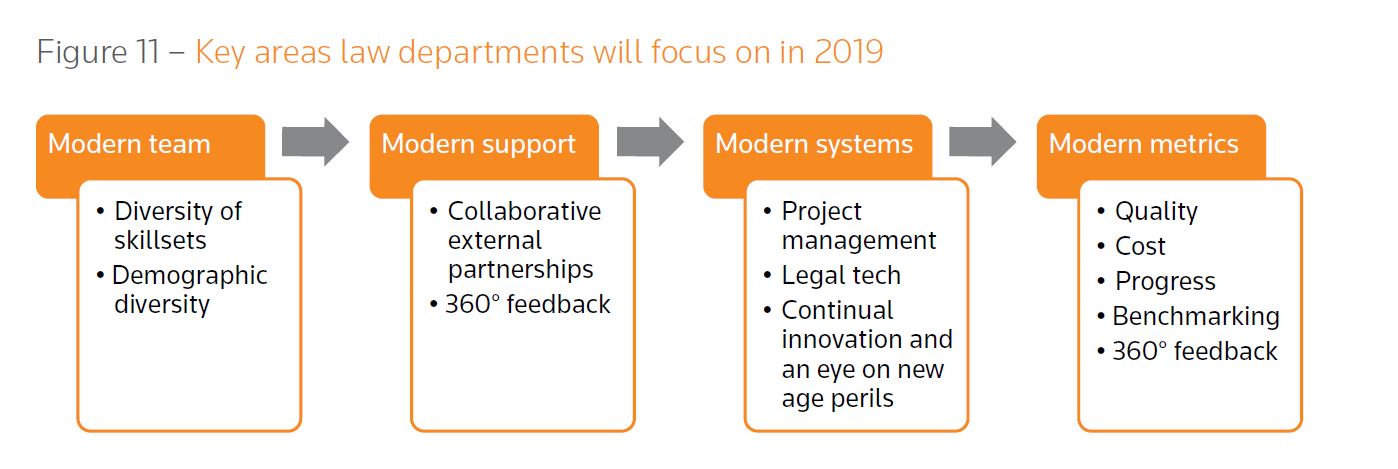Legal innovation goes hand-in-hand with a legal operations mindset, and it requires having the right team in place, the right technology, open collaboration with outside service providers, and the right metrics to ensure that execution fits the strategy.
Those are key takeaways from a new report, State of Corporate Law Departments 2019—published by Thomson Reuters Legal Executive Institute; the International Bar Association; the Corporate Legal Operations Consortium; and, the UK-based legal research firm Acritas. The report outlines five key levers that in-house legal departments can use to drive more value in their organisations, including:
- Creating high-performing teams with diverse skillsets;
- Developing professional project management skills;
- Building collaborative partnerships with external legal suppliers;
- Using gender diversity to enhance the quality of the legal function; and
- Creating an environment for successful innovation.
And a number of key findings in the report support that last lever about innovation, such as:
Innovation has a positive effect on how external firms view in-house departments—corporate law departments that embrace innovation are seen as 10 percent more effective by external lawyers. In-house lawyers who recognise their law firms as innovative are also given about 5 percent higher performance ratings across all criteria, according to Acritas data. The indicators of innovation include using technology, applying alternative pricing models, resourcing matters with contract lawyers or legal managed services, and delivering strong lawyer training and knowledge-sharing capabilities.
Use of technology is up among law departments of all sizes—large law departments lead the way, with 63 percent increasing their use of legal tech. Small law departments are next, with 52 percent increasing their use of tech. Overall, 45 percent of law departments surveyed by Acritas are increasing the application of technology to their work.
Two of the biggest barriers to innovation are lack of time and a risk-averse mindset—one of the key ways to deliver efficiency and quality is the existence of a dedicated legal operations function. More than 50 percent of corporate law department in the study now are staffed with legal operations professionals. Many of those professionals are charged with leading innovation initiatives and finding ways to automate processes and legal work.
Many legal technologies are beyond the cutting-edge phase—Acritas’ research shows that most of the legal technologies now applied in in-house departments are definitely beyond the ‘early adopter’ stage and are reaching the ‘early majority’ stage. Tech tools such as case management, contract management, workflow automation, e-signatures, and many others are now relatively commonplace.
But it’s not just about the technology, because building teams and collaboration across disciplines are key to innovation—teams need expertise from a wide variety of fields; and process improvement specialists, data analysts, and the like need to collaborate with in-house leadership and legal professionals. And this collaboration extends outward as well, with many legal departments partnering with their outside firms around technology and process.

Today’s corporate law departments need a multi-faceted strategy (summarised in the report’s Figure 11 above). It starts with putting the right team in place, with both demographic and skillset diversity. It includes collaborating across functions in corporate law departments, but also collaborating with external partners including law firms, alternative legal service providers, and contract staffing services.
A full-fledged technology strategy includes getting a handle on processes and using technology to constantly improve and build efficiencies. Finally, metrics are key to measuring success and for delivering on both cost and quality goals with accountability.
This article was originally published on Thomson Reuters Legal Executive Institute.
For a copy of the report ‘State of Corporate Law Departments 2019’ click here.


